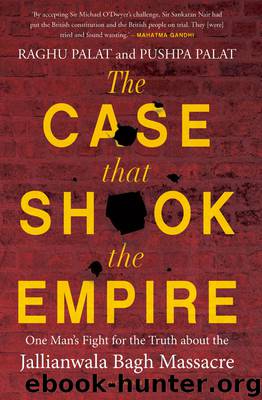The Case That Shook the Empire by Raghu Palat

Author:Raghu Palat
Language: eng
Format: epub
Publisher: Bloomsbury Publishing
While giving him the brief on the commission, Montagu told Hunter, ‘You might find men and newspapers anxious to lead you past alleys which you should explore in order that you may be prevailed upon to “whitewash”.’9 Hunter was told that the Government had nothing to fear from a searching inquiry and that its purpose was to restore public confidence and to present the truth to the world.
After convening in Delhi on 29 October, the committee met and interviewed witnesses in Delhi for eight days, in Ahmedabad for six days, in Bombay for three days and in Lahore for 29 days. With the exception of O’Dwyer and three others who gave their evidence in camera, all others gave their evidence in public. Even though the committee was not a court of law and witnesses were not questioned under oath, the members were successful, by rigorous cross-examination, to get detailed accounts. As these meetings were held in public, they were reported extensively in papers both in India and in England.
Montagu, on reading these reports, was concerned and wanted a parliamentary committee constituted. He invited Nair to London to give evidence before the parliamentary committee. Delighted to have the opportunity to present the facts, Nair readily agreed as he was determined to ensure that an incident as horrific as the Jallianwala Bagh massacre never occurred again.
Prior to his departure, Nair had a conversation with Lord Chelmsford. When he mentioned that he was visiting London on Montagu’s request, Chelmsford promptly informed the latter that there really was no need to invite Nair who was in any case planning on visiting London at his own expense, ensuring that Nair would not be accorded any of the benefits of being a guest of the Government. He would also have to pay his own passage money.
But expense was certainly not going to stop Sir Nair. He arrived in London a few days after the evidence of Dyer was reported in the Pioneer, where Dyer had testified to the commission that he had planned the shooting at Jallianwala Bagh in advance and that it was intended not just to disband and scatter the crowd but to produce a ‘moral impact’ across the country. More damning was his admission that he would have used machine guns and armoured cars if it had been possible. He finally admitted to the commission that he had made the decision to abandon the wounded, leaving them there to die.
Sir Nair brought Dyer’s admissions to the attention of John Robertson, editor of the Westminster Gazette, whose article the next day ‘created a sensation all over England’.10 Another Times article asked, ‘How comes it that a British general can inflict nearly 2000 casualties on an unarmed mob in the Punjab, without the full facts being forwarded within a reasonable time by the Viceroy to the Secretary of State? We have examined the whole of the Viceroy’s reports as transmitted to the Press in this country for publication, and they contain very little indication of what happened at Amritsar on the day in question.
Download
This site does not store any files on its server. We only index and link to content provided by other sites. Please contact the content providers to delete copyright contents if any and email us, we'll remove relevant links or contents immediately.
2010-The City & the City by China Miéville(1848)
Anatomy of Injustice by Raymond Bonner(1532)
That Every Man Be Armed by Stephen P. Halbrook(1480)
ADHD on Trial by Michael Gordon(1474)
Injustices by Ian Millhiser(1408)
You Don't Own Me by Orly Lobel(1362)
Tell by Major Margaret Witt(1316)
Course Correction by Ginny Gilder(1298)
A Vast Conspiracy by Jeffrey Toobin(1254)
Broken Scales by Joel Cohen(1238)
First by Evan Thomas(1189)
J by Howard Jacobson(1183)
Without Copyrights by Spoo Robert(1183)
A Religious Orgy in Tennessee by H.L. Mencken(1155)
The Run of His Life: The People v. O. J. Simpson by Jeffrey Toobin(1139)
A Triumph of Genius: Edwin Land, Polaroid, and the Kodak Patent War by Ronald K. Fierstein(1122)
A History Of Thailand by Baker Chris(1100)
John Wayne Gacy by Judge Sam Amirante(1037)
Law 101: Everything You Need to Know About American Law, Fourth Edition by Jay Feinman(1029)
